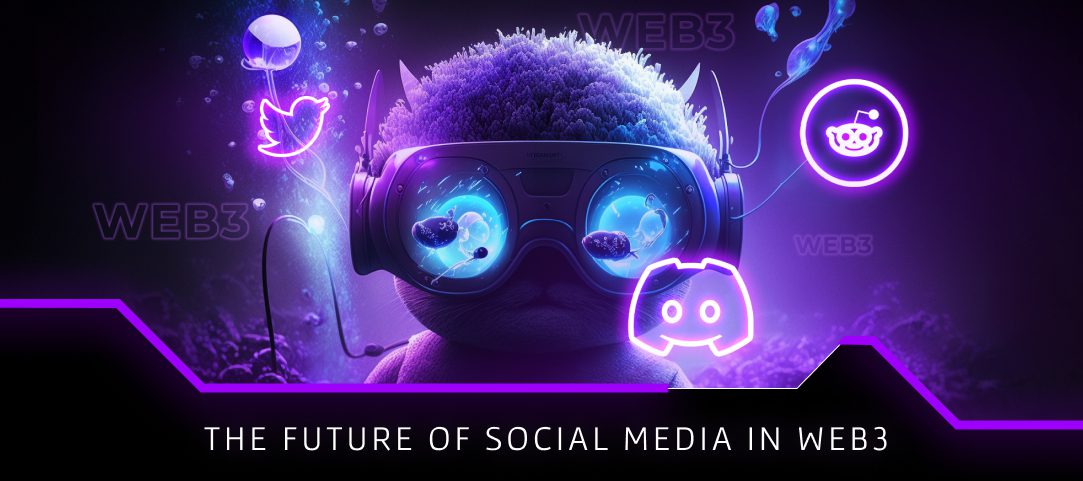As the developing Web3 space is bringing groundbreaking innovations across the wide web, social media is no exception. There are currently notable developments suggesting that the future social media landscape will likely be closely interlinked with Web3 core aspects.
In this article, we’ll discuss those developments that may reshape social media as we know it, including decentralization, emerging financial opportunities, and the unavoidable Metaverse. So, as the future won’t wait, let’s not waste time and begin!
How are social media giants embracing Web3

Apart from social media platforms designed from scratch to embrace the possibilities of Web3, we can already see existing platforms introducing new features left and right, that bring them closer to this next step in the evolution of the internet. Such features include:
- Telegram launching its Fragment marketplace, where you can register unique usernames by buying the pertaining NFTs;
- Twitter introducing the option to tip creators with Bitcoin by using the Strike service;
- You can now sign in to Discord through WalletConnect or MetaMask integrations;
- On Reddit, you can buy an NFT avatar through a specialized marketplace…
While remaining in the realm of Web2, these new features show that such platforms are recognizing the potential of Web3 and are trying to evolve lest they end up outdated and forgotten.
Although we can expect to see more such features in the future, these older platforms are still faced with a number of issues that new Web3 platforms are trying to solve.
Advantages of fully Web3 social media

The future is decentralized
Currently popular platforms are centralized, meaning all the power is essentially in the hands of a single entity. Thus, there’s plenty of room for malversation and wrongful doings.
Social media giants like Facebook and Instagram receive much criticism for mishandling users’ private data and the flow of misinformation on their platforms — and it’s quite hard, if not impossible, for us, the people, to even begin solving this issue. Moreover, it’s these entities that dictate all the rules and can decide what content to censor and which profiles to make non grata.
Web3 brings decentralization to the table. By accessing the network through decentralized applications (dApps), users can directly connect to the platform without needing the technology powering centralized servers. And by using community tokens akin to NFTs, which prove their identity and ownership stake, users can jointly impact the development of the emerging social media DACs – decentralized autonomous communities, that are as far from the rule of the powerful few as possible. With power being shared, users have more control over their data than ever, and in a transparent environment.
As the real world outside more and more resembles a dystopian society from cyberpunk fiction, with Web3, we can see social media moving closer to a utopia, with its transparency, ownership rights and shared governance duties.
A new frontier for making money online
Unlike Web2 social media, the next phase brings many opportunities to make money for those unsatisfied with simply spending time with friends online. For instance, decentralized platforms like Steemit, Yup, and Dataverse allow users to curate collections of interesting content and earn cryptocurrency from user “likes”. With so much content of all kinds, we’re used to sorting out the wheat from the chaff – and this is a way to connect to fellow humans by sharing our favorite pieces of anything and also making some money on the side. Not bad at all.
But creators are not disregarded, too. In Web3, platforms such as Patreon are considered a thing of the past. For instance, the Unlock platform allows creators to set up a membership program and grant access to its tiers by selling NFTs, which is an approach also taken by popular platforms like RareCircles and Coinvise. On Rally, on the other hand, you can sell access to special events and merchandise by creating for this purpose and then selling your very own cryptocurrency.
Whether it’s creators or curators though, both are seeing substantial financial benefits from the intersection of Web3 and social media, and in this regard, possibilities for future innovation are nigh endless.
Enter the Metaverse
One of the key features of Web3 is, of course, the famous Metaverse. It’s a concept seemingly straight out of science fiction, being a digital world inhabited by users represented by their respective avatars. It’s like a social network in the form typically associated with video games.
Let’s take Second Life, the first metaverse to emerge, as a representative example. There are no quests to solve or monsters to kill. Instead, users freely interact in chosen communities, spend time with each other, travel, attend events like concerts and art exhibitions, or trade virtual goods. Monetization is involved here too, as there’s a strong economy based on the virtual currency Linden Dollar, later exchanged for US dollars.
While such metaverses, including Meta’s own Horizon Worlds, are not intended to compete directly with browser-based social media, they represent an exciting socially-driven Web3 alternative.
What future holds

While the innovations discussed are positive ones and suggest the direction social media could likely take, we should note that it’s still not a guarantee of this new paradigm being put in place. The question yet remains whether social media users are going to hop onto the bandwagon and totally embrace social media platforms as envisioned by the many, many Web3 enthusiasts. The challenges yet remain, still, it’s undoubtable the high potential is there.










